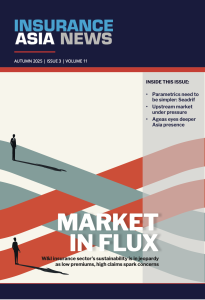Hong Kong’s connectivity with GBA has reinforced its role as a global risk management centre, IA’s Clement Cheung
September 25 2024 by Georgina Lee
The SAR is well-placed to be a hub for captives, especially by mainland enterprises to holistically monitor their overseas project risks and scale up their intra-group risk management capacity, says the regulator’s CEO.
With a mature and developed market, geographical proximity and cultural affinity, Hong Kong is the best place for mainland residents to satisfy their financial management and personal protection needs, according to Clement Cheung, the chief executive of the Hong Kong Insurance Authority.
The city also has the essential ingredients of a successful insurance-linked securities (ILS) domicile: world-class financial infrastructure, vibrant capital market, an impressive array of professional service providers, strong governmental support and unique connectivity with the Greater Bay Area (GBA).
Building on this solid foundation, the IA is stepping up efforts in identifying potential sponsors, engaging relevant authorities in the mainland, widening the range of product structures, enriching the risk types and promoting the awareness of institutional investors in Asia, Cheung said.
“We are already seeing some early successes – the five ILS issuances that took place here are led by mainland reinsurer and direct insurer, local reinsurer and the World Bank. Efforts to forge a viable ecosystem will continue to intensify,” he told InsuranceAsia News.
GBA’s risk management centre
Apart from establishing after-sales service centres in the GBA to render comprehensive support for those holding insurance policies acquired in Hong Kong, the IA is also examining feasible ways to address the challenges posed by the city’s demographic changes.
“To achieve this, we are looking at tailored insurance products that enable Hong Kong citizens to plan for their retirement at quality and affordable residential care facilities located in the wider confines of the GBA,” Cheung said.
“To bridge protection gaps and deepen financial inclusion, the IA is coordinating industry practitioners and the academia to improve data quality and availability, upgrade risk modelling sophistication and refine climate-related policies and disclosure standards.” Clement Cheung, HKIA
The nine mainland cities in the GBA have an average insurance penetration rate of only 5.14% and an insurance density of around RMB7,200 (17.2% and HK$68,400 in Hong Kong respectively), there is huge potential for stable and sustained growth of new business derived from visitors from these cities.
Narrowing protection gap
Insurers play a crucial role in strengthening community resilience by shouldering losses and speeding up reconstruction.
The rising frequency and severity of climate-related events are driving up claims and the level of premiums, threatening to make insurance coverage less accessible.
“To bridge protection gaps and deepen financial inclusion, the IA is coordinating industry practitioners and the academia to improve data quality and availability, upgrade risk modelling sophistication and refine climate-related policies and disclosure standards,” Cheung noted.
With the wellbeing of the GBA in mind, the IA is collaborating with insurers and research institutions to explore innovative solutions (such as parametric products for flooding), with a view to bolstering our risk management capacity.
“Insurers are major institutional investors that can perform an impactful role in directing funds to green projects and transition financing,” the regulator said, adding that the IA “will work with other financial regulators participating in the Green and Sustainable Finance Cross-Agency Steering Group to facilitate this through viable means”.
Captives pivotal to Belt & Road
Hong Kong also is well-placed to be a hub in developing the captive market, especially by mainland enterprises to holistically monitor their overseas project risks and scale up their intra-group risk management capacity.
“Captives can also play a pivotal role in supporting the Belt & Road projects, particularly in energy transition away from fossil fuels, risk management related to other fast-growing sectors such as electric vehicles that would benefit from sustainable development,” according to Cheung.
Geopolitical tensions have aggravated uncertainties that hinder cross-border trade and investment, preventing many developing economies from uplifting the living standards of their people. The use of captives is effective in encouraging corporations to venture into new markets or expand their footprint.
The tax concessions for captives and the expanded scope of insurable risks by captives introduced in 2013 and 2020 respectively have put Hong Kong on par with other leading captive domiciles, Cheung claimed.
A strategy and an action plan are now being formulated to guide future efforts and reinforce our value propositions.
The IA is reaching out to local corporations either with a captive operating elsewhere or has the potential to benefit from a captive to better understand their needs and circumstances. Some of them are likely to set up captives in Hong Kong, he added.
-
QBE | Elevating customer experience, humanising claims: QBE Asia’s ‘Solutions in a Box’
Vastly improving turnaround times and personalising service delivery, QBE Asia’s award-winning, end-to-end bundled claims solutions is a game-changer for the insurance industry.
-
Beazley | What does cyber protection look like from day 1 to day 600 and beyond?
Cybersecurity is no longer just an IT concern, but a governance issue that belongs on the boardroom agenda.
-
Sedgwick | Preparing for the next storm
Insurance industry needs to recalibrate, invest in innovation and strengthen systems, talent and data practices.
-
Peak Re | From climate modelling to market opportunity: Forging a new clarity on Southeast Asia’s climate risk
Southeast Asia's protection gap: a crisis of clarity, not just capital

